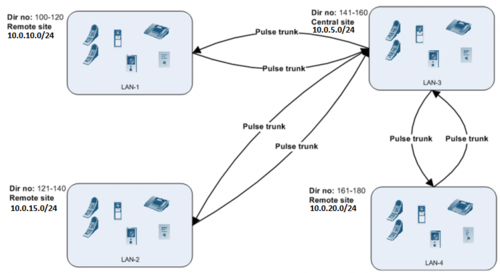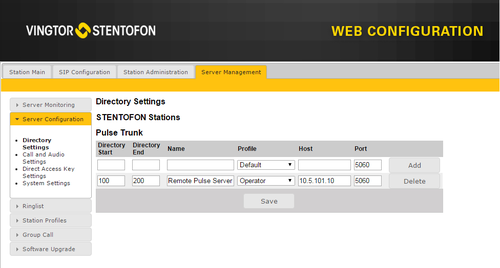Pulse Trunking: Difference between revisions
From Zenitel Wiki
| Line 38: | Line 38: | ||
* '''Port:''' The SIP port used. Normnally 5060. | * '''Port:''' The SIP port used. Normnally 5060. | ||
== | ===Configuration example=== | ||
| Line 47: | Line 47: | ||
|Saturn | |Saturn | ||
|- | |- | ||
|'''IP Address''' | |'''Pulse server IP Address''' | ||
|192.168.1.10 | |192.168.1.10 | ||
|- | |- | ||
| Line 60: | Line 60: | ||
|Venus | |Venus | ||
|- | |- | ||
|'''IP Address''' | |'''Pulse server IP Address''' | ||
|192.168.5.10 | |192.168.5.10 | ||
|- | |- | ||
Revision as of 10:15, 16 June 2017
Pulse Trunking makes it possible to call between different Pulse systems. The routing between Pulse systems are easily configured in the Pulse Server Directory.
Prerequisites
- The Pulse Server must be a station in the Turbine family with software version 4.2.3.9 or higher. Note that Pulse Trunking is not supported when INCA Station is used as Pulse Server.
When using a Pulse server with ver. 4.7:
- A Pulse Enterprise License (Item no. 1009660002)
When using a Pulse server with ver. 4.2:
- A Pulse Enterprise License (Item no. 1009660002)
- A Pulse Trunking License (Item no. 1009662101) per route.
Features
- Easy to configure and setup
- Supports supplementary functions such as door opening, call transfer, call forwarding, ringlist and station profiles
Configuration
Pulse Trunk Routes must be configured to enable calls between different Pulse sites. A route consists of:
- Directory Number range (To - From) in the remote site
- Logical name for the route
- IP address and SIP port of the remote Pulse Server (Pulse Server SIP port is normally 5060)
- Profile to assign calls coming from/to the route. Profiles can be used to restrict access to/from a route
Note that transit calls are not possible. There must be a direct route from the calling Pulse site to the called Pulse site.
To add a route on a Pulse Server, select Server Management > Server Configuration > Directory Settings
- Directory Start: First number in the remote Pulse system.
- Directory End: Last number in the remote Pulse system. The number range must have the same amount of digits. For example 200 - 299, not 50 - 150.
- Name: Logical name for the route. Any text can be used.
- Profile: Profile to assign calls coming from/to the route. Profiles can be used to restrict access to/from a route.
- Host: IP-Address of remote Pulse Server
- Port: The SIP port used. Normnally 5060.
Configuration example
| Name | Saturn |
| Pulse server IP Address | 192.168.1.10 |
| Numberplan | 40-80 |
| Name | Venus |
| Pulse server IP Address | 192.168.5.10 |
| Numberplan | 120-160 |
IMPORTANT INFO REGARDING MULTIPLE PULSE SYSTEMS ON ONE LAN IP SUBNET Because of the Pulse auto-detect and configuration, it is NOT recommended to run multiple Pulse Systems on the same LAN IP-Subnet. If you still, despite our recommendations want to run multiple Pulse system on the same lan subnet, we strongly recommend that you -Connect and set up Pulse system 1 -Disconnect Pulse system 1 -Connect and set up Pulse system 2 -When done with all separate configuration, connect both Pulse systems. If you are going to do configuration changes, please remember to disconnect the other Pulse system from the network.
Limitations
- Transit calls: A client may only call to sites to which there is a direct route. In the example in the top of this article, the satellite Pulse sites may only call to central site, while central site can call all sites.
- Call Transfer/Forwarding can only be done to stations to which there is a direct route.
- Group calls: It is not possible to do group calls from one Pulse system to another.



